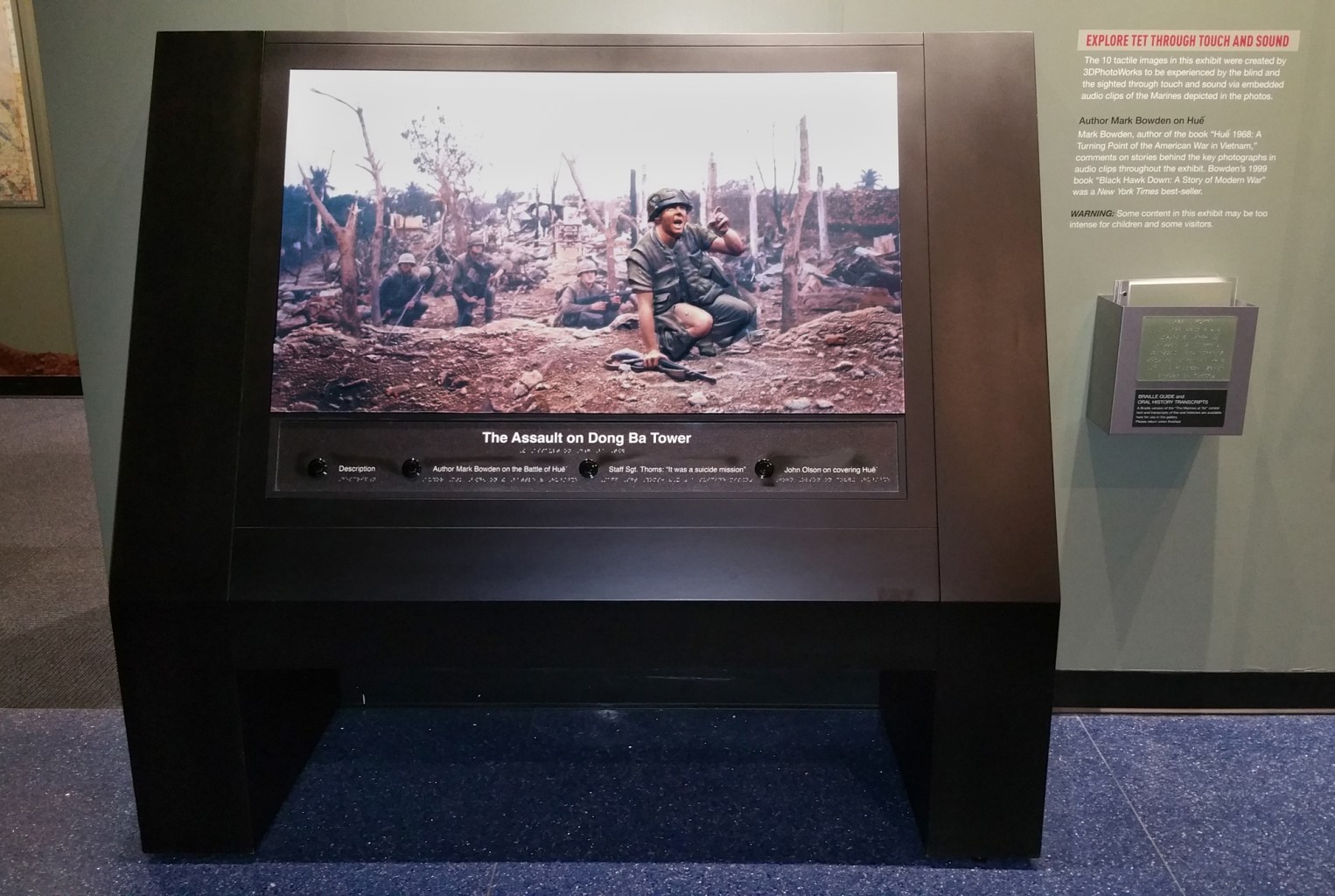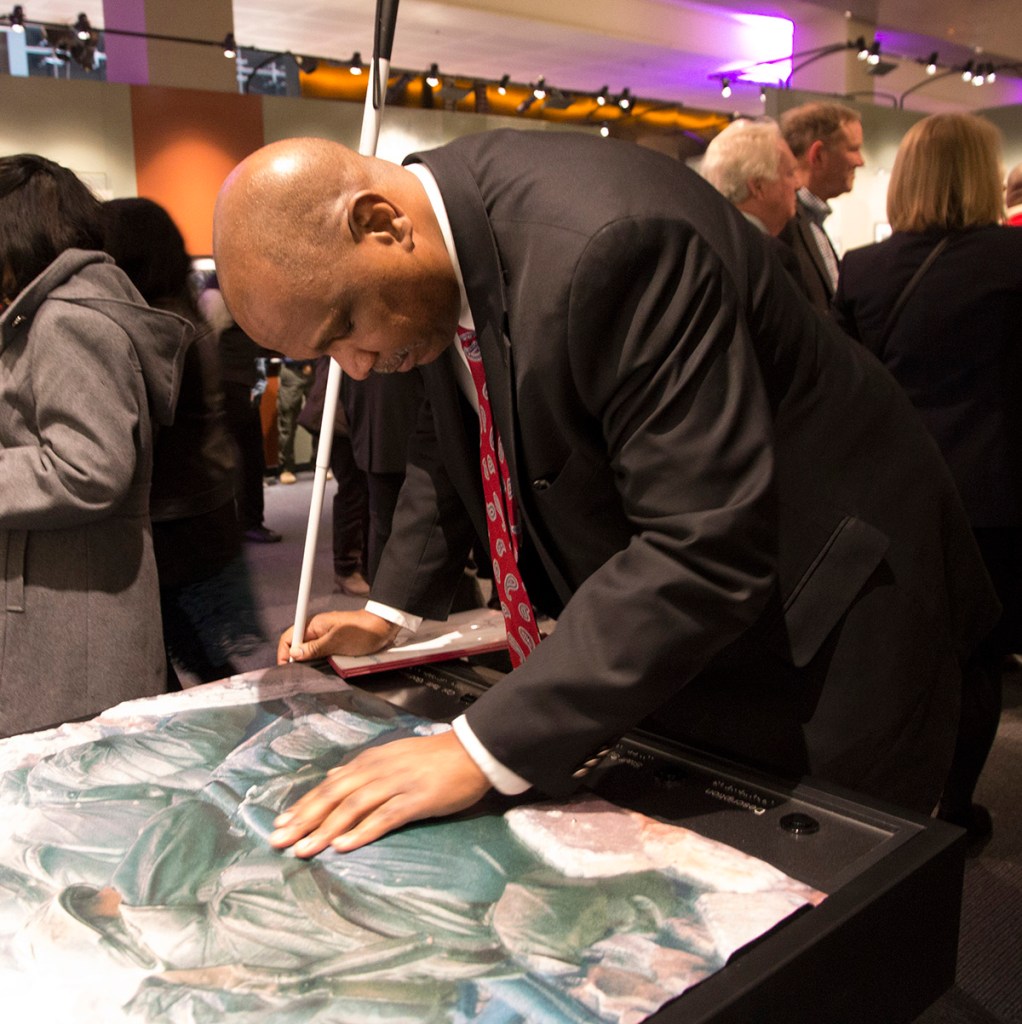
The opportunity to experience photography, art, and other museum exhibits can be life-altering to a blind person.
“As a blind person, when I can experience a painting on my own without asking for help, that represents increased freedom, independence, and equality,” said Lynn Jackson, a retired human resources worker from Memphis who became blind at age 60.
But too often museums do a poor job of engaging blind and low-vision patrons.
With the mutual goal to address this, the Newseum, 3DPhotoWorks, and the National Federation of the Blind joined forces in the fall of 2017 to create a groundbreaking exhibit: the first photography exhibit in the United States designed for the blind and people with low vision.

The Marines and Tet: The Battle That Changed the Vietnam War told the story of how the Tet Offensive helped shift attitudes against the war, using photography, three-dimensional tactile images, and audio clips of the Marines who fought in the battle (plus a doctor who treated them), and were interviewed decades later about the experience. When visitors touched details in the three-dimensional images, embedded sensors played brief audio descriptions, using 3DPhotoWorks’s museum accessibility technology.
3DPhotoWorks, co-founded by John and Nancy Olson in 2008, specializes in tactile fine art printing for the blind and people with low vision. For nearly a decade, the company has partnered with the National Federation of the Blind to develop technology that brings art and images to life for people with little or no sight.
“Museums are educational, entertaining, and provide critical social connections for the blind and the sighted,” said Mark Riccobono, president of the NFB. “The National Federation of the Blind is committed to making the arts more accessible for all people.”
As museums look for ways to make exhibit content more accessible to the blind, some have experimented with this tactile image technology, including the Canadian Museum for Human Rights and the Virginia Museum of Fine Arts.
The Newseum has also shown other tactile photographs in its galleries, including a prize-winning portrait of Mother Teresa, a famous photo of then-Sen. John F. Kennedy on the campaign trail, and a photo of Olympic athletes Tommie Smith and John Carlos raising their fists in protest at the 1968 Olympics. These tactile experiences have proved so popular that the Kennedy photo had to be refurbished during the exhibit run, because the friction of so many hands had worn down the nose in the image. That was just a small indication of the power of combining photography with tactile images and sound, not just for the blind but for all visitors.
Getting Feedback from Blind Visitors
When designing exhibits to be accessible to the blind, it is critical to include blind visitors themselves in the process. For The Marines and Tet, more than 300 blind visitors attended the opening night program as a hands-on test audience, and suggested improvements that made the exhibit better for all visitors. For example, when they pointed out that speakers embedded in the tables housing the tactile photographs were muffled when they got close to the photographs to explore them, we moved the speakers above the images instead.

Seeing how useful this feedback was for the Newseum, the NFB decided to expand its commitment to museums and attend the AAM Annual Meeting alongside 3DPhotoWorks to provide expertise and support directly to museum leadership.
Museum professionals were able to hear directly from blind visitors through one-on-one conversations at the 3DPhotoWorks booth on the MuseumExpo floor about what designers should consider when creating universal design for exhibits and spaces, and to hear from Christoffersen, Olson, Lewis, and designer Corey Timpson in the panel “Inclusion: Rich Experience Design for All.”
3DPhotoWorks and the NFB also partnered to distribute free Accessibility Kits to attendees, complete with a sample tactile image to explore.
Advice for Museums Seeking to be More Inclusive
Universal accessibility for public museums isn’t just a noble goal; it’s the law. But we should strive to go beyond what the law requires, to create an experience that is not only accessible but truly engaging.
For the Newseum, in addition to tactile photographs, this means providing descriptive audio tours, Braille versions of exhibit text, open-captioned videos with descriptive audio tracks available, and exhibit elements designed so they are within easy access from a seated position for visitors who use wheelchairs.
As the field endeavors to make museums more inclusive and reflective of their communities, part of the work is making the experience more engaging for people with disabilities. To that end, here are some practical tips for making your exhibits more accessible to visitors with low or no vision:
- Involve people who are blind early in the process. The Newseum decided to develop the Marines and the Tet exhibit with an extraordinarily short turnaround time, to have it open in time to mark the fiftieth anniversary of the Tet Offensive. Because of this, the feedback received from blind visitors on opening night required some adjustments to the exhibit, which could have been avoided with some advance prototyping.
- Reach out to the experts. The National Federation of the Blind, with headquarters in Baltimore and affiliates across the country is available for consultation. The American Alliance of Museums provides resources as well.
- Get an Accessibility Kit. Email John@3DPhotoWorks.com for a kit, complete with a conventional fine art print of Vincent van Gogh’s painting, Dr. Gachet; a 3D tactile image of that print; a list of accessibility resources compiled by the NFB and 3DPhotoWorks; additional information regarding access and inclusion support, and valuable contact information for the NFB and 3DPhotoWorks.
Would your museum like to become a destination for seven million new visitors? That’s the number of blind and low-vision Americans, according to the National Federation of the Blind. Worldwide, that number expands to 285 million people.
Exhibits with tactile elements help create a more inclusive society, one that the blind community can be a part of and enjoy independently. Tactile exhibits require active, direct participation from a visitor with no intermediary. For the blind, that’s an extraordinary gift: a chance to experience culture and history in an accessible, inclusive environment.
About the authors:
Carrie Christoffersen is the Executive Director and Curator of the Newseum
Anil Lewis is the Executive Director for Blindness Initiatives at the National Federation of the Blind
John Olson is the co-founder of 3DPhotoWorks
Skip over related stories to continue reading article







Comments